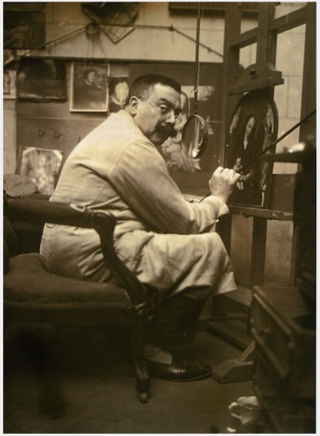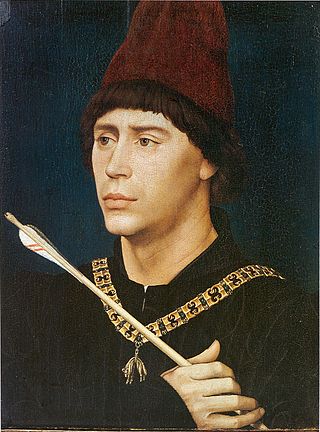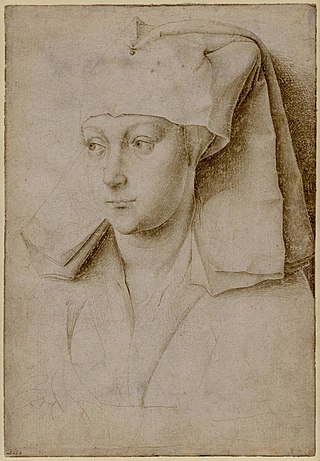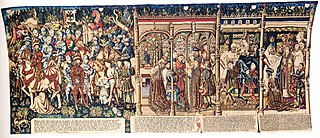
Rogier van der Weyden or Roger de la Pasture was an early Netherlandish painter whose surviving works consist mainly of religious triptychs, altarpieces, and commissioned single and diptych portraits. He was highly successful in his lifetime; his paintings were exported to Italy and Spain, and he received commissions from, amongst others, Philip the Good, Netherlandish nobility, and foreign princes. By the latter half of the 15th century, he had eclipsed Jan van Eyck in popularity. However his fame lasted only until the 17th century, and largely due to changing taste, he was almost totally forgotten by the mid-18th century. His reputation was slowly rebuilt during the 200 years that followed; today he is known, with Robert Campin and van Eyck, as the third of the three great Early Flemish artists, and widely as the most influential Northern painter of the 15th century.

Robert Campin, now usually identified with the Master of Flémalle, was a master painter who, along with Jan van Eyck, initiated the development of Early Netherlandish painting, a key development in the early Northern Renaissance.

Early Netherlandish painting is the body of work by artists active in the Burgundian and Habsburg Netherlands during the 15th- and 16th-century Northern Renaissance period, once known as the Flemish Primitives. It flourished especially in the cities of Bruges, Ghent, Mechelen, Leuven, Tournai and Brussels, all in present-day Belgium. The period begins approximately with Robert Campin and Jan van Eyck in the 1420s and lasts at least until the death of Gerard David in 1523, although many scholars extend it to the start of the Dutch Revolt in 1566 or 1568–Max J. Friedländer's acclaimed surveys run through Pieter Bruegel the Elder. Early Netherlandish painting coincides with the Early and High Italian Renaissance, but the early period is seen as an independent artistic evolution, separate from the Renaissance humanism that characterised developments in Italy. Beginning in the 1490s, as increasing numbers of Netherlandish and other Northern painters traveled to Italy, Renaissance ideals and painting styles were incorporated into northern painting. As a result, Early Netherlandish painters are often categorised as belonging to both the Northern Renaissance and the Late or International Gothic.

Josephus Maria Van der Veken was a Belgian art restorer, copyist, and art forger who mastered the art of reproducing the works of early Netherlandish painters.

Jacques Daret was an Early Netherlandish painter born in Tournai, where he would spend much of his life. Daret spent 15 years as a pupil in the studio of Robert Campin, alongside Rogier or Rogelet de le Pasture, and afterwards became a master in his own right. He became a favorite of the Burgundian court, and his patron for 20 years was the abbot of St. Vaast in Arras, Jean de Clercq.

Jacques of Savoy, Count of Romont was a member of the House of Savoy and military commander during the Burgundian Wars.

Ferry de Clugny, Cardinal and Bishop of Tournai was a highly placed statesman and ecclesiastic in the service of the Dukes of Burgundy.

The Descent from the Cross is a panel painting by the Flemish artist Rogier van der Weyden created c. 1435, now in the Museo del Prado, Madrid. The crucified Christ is lowered from the cross, his lifeless body held by Joseph of Arimathea and Nicodemus.

The Magdalen Reading is one of three surviving fragments of a large mid-15th-century oil-on-panel altarpiece by the Early Netherlandish painter Rogier van der Weyden. The panel, originally oak, was completed some time between 1435 and 1438 and has been in the National Gallery, London since 1860. It shows a woman with the pale skin, high cheek bones and oval eyelids typical of the idealised portraits of noble women of the period. She is identifiable as the Magdalen from the jar of ointment placed in the foreground, which is her traditional attribute in Christian art. She is presented as completely absorbed in her reading, a model of the contemplative life, repentant and absolved of past sins. In Catholic tradition the Magdalen was conflated with both Mary of Bethany who anointed the feet of Jesus with oil and the unnamed "sinner" of Luke 7:36–50. Iconography of the Magdalen commonly shows her with a book, in a moment of reflection, in tears, or with eyes averted.

Vrancke van der Stockt was an early Netherlandish painter. He is most notable as a "direct heir and popularizer" of Rogier van der Weyden.

Durán Madonna is an oil on oak panel painting completed sometime between 1435 and 1438 by the Netherlandish painter Rogier van der Weyden. The painting derives from Jan van Eyck's Ince Hall Madonna and was much imitated subsequently. Now in the Prado, Madrid, it depicts a seated and serene Virgin Mary dressed in a long, flowing red robe lined with gold-coloured thread. She cradles the child Jesus who sits on her lap, playfully leafing backwards through a holy book or manuscript on which both figures' gazes rest. But unlike van Eyck's earlier treatment, van der Weyden not only positions his Virgin and Child in a Gothic apse or niche as he had his two earlier madonnas, but also places them on a projecting plinth, thus further emphasising their sculptural impression.

Portrait of Antoine, 'Grand Bâtard' of Burgundy is an oil panel painting by the Netherlandish painter Rogier van der Weyden portraying Anthony of Burgundy, the bastard son of Philip the Good and one of his mistresses, Jeanne de Presle. The panel is dated to about 1460 and held in the Royal Museums of Fine Arts of Belgium, Belgium.

Portrait of a Young Woman is a drawing by the Flemish artist Rogier van der Weyden. It depicts a young woman wearing a headscarf pinned to her hair and has been variously dated as c. 1430s and c. 1440 - 1445. The identity of the woman has not been established, nor her social class. The drawing is presumably a study for a painted portrait now lost, but likely to have been similar to the Portrait of a Woman in Berlin.

The Justice of Trajan and Herkinbald was a set of four large panels painted by the Flemish painter Rogier van der Weyden that decorated one wall of a court-room in the Town Hall of Brussels. They represented the Justice of Trajan, a Roman emperor, and the Justice of Herkinbald, a legendary Duke of Brabant. The panels were intended as a reminder to judges to dispense impartial justice and were admired by generations of visitors, including Albrecht Dürer.

Pietà is a painting by the Flemish artist Rogier van der Weyden dating from about 1441 held in the Royal Museums of Fine Arts of Belgium, Brussels. There are number of workshop versions and copies, notably in the National Gallery, London, in the Prado, Madrid, and in the Manzoni Collection, Naples. Infrared and X-radiograph evidence suggest that the Brussels version was painted by van der Weyden himself, not necessarily excluding the help of workshop assistants. Dendrochronological analysis gives a felling date of 1431 for the oak panel backing, supporting the dating of the painting to around 1441.

The Virgin and Child is a painting by the Flemish artist Rogier van der Weyden dating from after 1454 in the collection of the Museum of Fine Arts, Houston.

Jean Wauquelin presenting his 'Chroniques de Hainaut' to Philip the Good is a presentation miniature believed to have been painted by the Flemish artist Rogier van der Weyden. It decorates the frontispiece to the Chroniques de Hainaut, MS KBR.9242, Jean Wauquelin's French translation of a three-volume history of the County of Hainaut originally written in Latin by the 14th-century Franciscan historian Jacques de Guyse.

Goswin van der Weyden or Goossen van der Weyden (1455–1543) was a Flemish Renaissance painter active in Antwerp. He was one of several artists from Brussels who assisted in the transmission to Antwerp of the traditions of the Brussels school founded by his grandfather, Rogier van der Weyden. He thus played an important role in the founding of the Antwerp school.

Portrait of Philip the Good is a lost oil on wood panel painting by the Early Netherlandish painter Rogier van der Weyden, dated variously from the mid 1440s to sometime after 1450.

The Chronicles of Hainaut is an illuminated manuscript in three volumes, tracing the history of the county of Hainaut up to the end of the 14th century. Its text was produced around 1446-1450 by Jean Wauquelin as a French translation of Annales historiae illustrium principum Hannoniæ, a three-volume Latin work produced by Jacques de Guise around 1390-1396. It was made for Philip the Good of Burgundy and is now in the Royal Library of Belgium in Brussels.

























